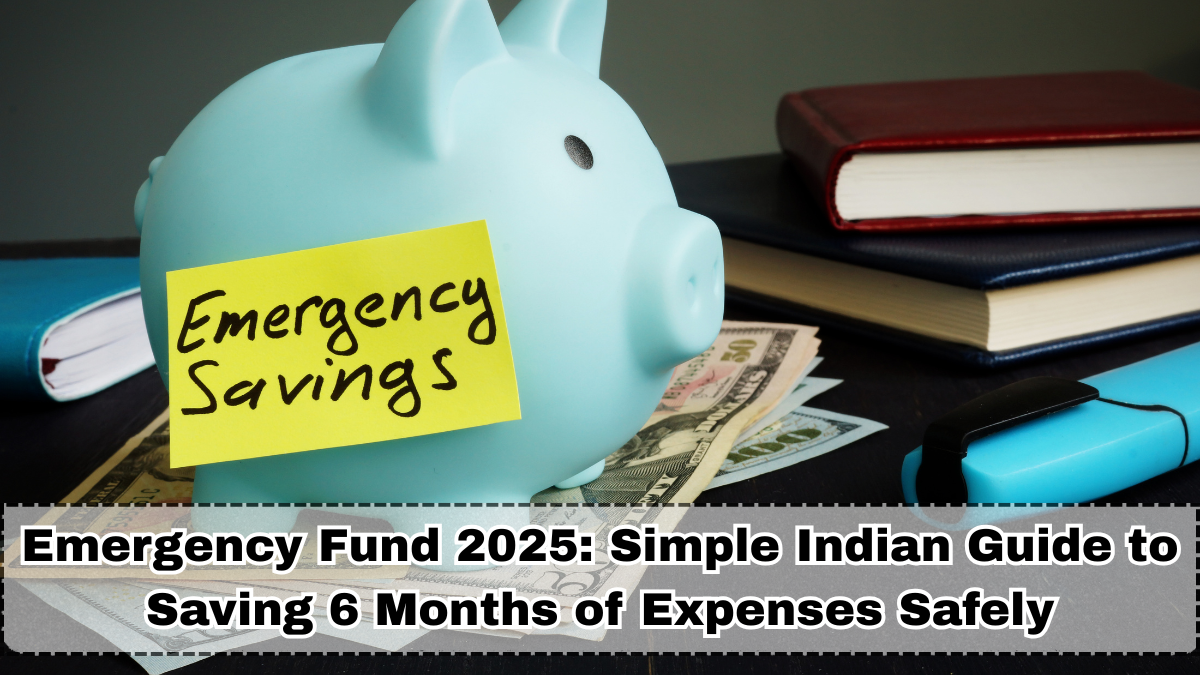Unexpected expenses can shake any Indian household — from medical bills and job loss to sudden travel or emergency repairs. That’s why 2025 has seen a huge rise in searches for emergency fund planning India, especially among young professionals and middle-class families looking for financial stability.
Building an emergency fund doesn’t require high income or complicated investing. What you need is a clear plan, a safe place to store the money and the discipline to maintain it. This guide explains how to build a 3–6 month emergency fund in a simple, practical way that works for Indian lifestyles.

Why Every Indian Household Needs an Emergency Fund in 2025
The last few years have shown how unpredictable life can be. Even with stable jobs, financial surprises can arrive anytime.
Reasons emergency funds are essential
• Rising layoffs in tech and startups
• Unexpected medical emergencies
• Sudden rent increases or relocation needs
• Car or bike repair expenses
• Family responsibilities like weddings or travel
• Peace of mind during uncertain times
An emergency fund acts as a financial seatbelt — comforting, dependable and always ready.
How Much Emergency Fund Do You Really Need?
Most experts recommend saving 3 to 6 months of essential expenses, not income. This amount should cover the non-negotiable monthly costs that keep your household running.
Calculate using
• Rent or home EMI
• Groceries
• Utilities (electricity, water, internet)
• Medical expenses
• School fees (if applicable)
• Travel or commute costs
For example, if your essential monthly expense is ₹30,000, your ideal emergency fund is ₹90,000 to ₹1,80,000.
Step 1: Determine Your Monthly Essentials
Before saving, you need clarity. List out only what is essential. Avoid including luxury items, subscriptions or weekend outings.
Essential categories
• Housing
• Food
• Transport
• Utilities
• Healthcare
• Education
• Elder care
This gives you a realistic estimate of how much you should keep aside.
Step 2: Set a Target and Automate Your Savings
Once you know your target, break it into smaller monthly amounts. Automation helps you stay disciplined without overthinking.
Ways to automate
• Auto-transfer from salary account
• SIPs in liquid mutual funds
• Standing instructions to savings account
Most Indian families reach their emergency fund target within 6–12 months using this structured approach.
Step 3: Choose the Right Place to Keep Your Emergency Fund
Your emergency fund must be
• Safe
• Liquid (easy to withdraw anytime)
• Stable
Top options Indians prefer in 2025
• High-interest savings account
• Liquid mutual fund
• Sweep-in FD
• Short-term FD (3 months–1 year)
Avoid locking emergency money in long-term FDs or risky assets.
Savings Account vs FD vs Liquid Fund — What Should You Choose?
Each option has pros and cons depending on your needs.
Savings account
• Very easy access
• Instant withdrawal
• Lower interest
Liquid fund
• Higher returns
• Same-day or next-day withdrawal
• Good for amounts above ₹50,000
Sweep-in FD
• Higher interest than savings
• Auto-breaks when needed
• Best for 1–3 lakh emergency fund
Choose the option that fits your comfort level.
How to Build an Emergency Fund on a Low Income
Even with limited income, building a small emergency fund is possible with consistent saving.
Practical strategies
• Start with ₹500–₹1,000 per month
• Cut optional expenses for 3 months
• Use cashback apps and reward points
• Allocate bonuses or freelance income
• Sell unused items at home
Every small amount contributes to long-term financial security.
Mistakes Indians Make While Planning Emergency Funds
Avoiding these mistakes can help you stay financially safe.
Common mistakes
• Keeping money in risky investments
• Using emergency fund for shopping or travel
• Not refilling the fund after using it
• Saving less than 1 month of expenses
• Mixing emergency money with regular savings
Discipline matters more than the amount.
How to Maintain and Grow Your Emergency Fund in 2025
Your emergency fund is not a one-time setup. You must review it regularly as expenses change.
Good habits to follow
• Review expenses every 6 months
• Increase fund size when income grows
• Keep adding small amounts monthly
• Refill the fund immediately after withdrawals
• Maintain separate accounts for clarity
A well-maintained fund supports you for life.
Why an Emergency Fund Reduces Stress and Improves Life Quality
Financial uncertainty creates hidden stress. Knowing you have a fund for emergencies brings confidence and emotional security.
Benefits beyond money
• Better sleep
• Less anxiety during problems
• More freedom to take risks
• Confidence to switch jobs
• Stronger family stability
This is why an emergency fund isn’t just financial planning — it’s life planning.
Final Thoughts: Start Small, Stay Consistent, and Build Security
You don’t need a high salary or big savings to build an emergency fund. What you need is consistency and a clear plan. With rising uncertainties and increasing responsibilities, emergency fund planning India has become essential for every household in 2025.
Start with whatever amount you can, automate your savings and choose the safest place to store your money. Over time, your emergency fund becomes your strongest financial safety net.
FAQs
How much should my emergency fund be in India?
At least 3–6 months of essential expenses.
Can I keep my emergency fund in stocks?
No, risky assets should be avoided.
What is the safest place to store emergency funds?
High-interest savings, liquid funds or sweep-in FDs.
Should I refill the fund after using it?
Yes, immediately.
How long does it take to build an emergency fund?
Usually 6–12 months, depending on income and expenses.
Click here to know more.
